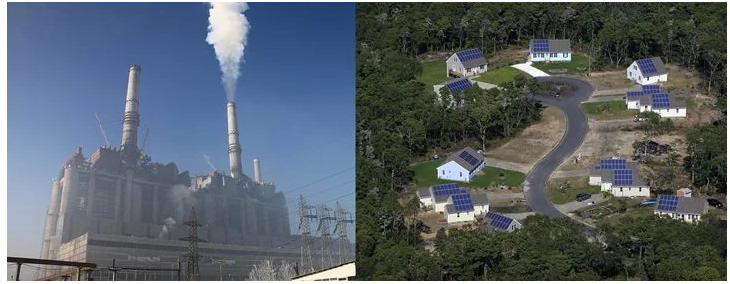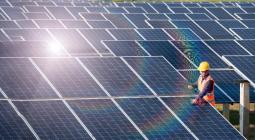Who pays for grid upgrades when big solar developers force out the little guy?

In short: In some rural places, large solar developers build as much solar as they can without incurring costs to upgrade the feeder lines that carry electricity to the rest of the grid. This leaves people looking to install small systems to offset their own usage unable to do so without paying the huge costs for grid upgrades. The question is, who should pay for those costs, and when?
In January, 2020, Oregon public media told a story about Scott Zollinger, a homeowner who wanted to install solar panels to offset some of his family’s electricity use. He found a contractor and had even made the first payment on the system when he received a letter from the utility company denying his request to connect to the grid.
Long story short, the utility explained that the substation equipment needed to carry electricity back to the grid from the farmer’s solar panels needed to be upgraded, because large commercial solar installations in his area had already taken up all the available capacity with the current equipment. The cost of the necessary upgrades was nearly 10 times as much as the solar panels Mr. Zollinger intended to install.
What’s worse is: the builder of the commercial solar installation likely knew of the grid limits, and installed just enough to meet, but not exceed, that threshold. And 11 of 650 other areas within the utility’s service territory—nearly 2% of it’s total energy grid—have the same problem.
Who should pay for grid upgrades?
Asking a homeowner to pay $500,000 for upgrades to the grid so they can install a $50,000 system on their roof seems awfully unfair. Does it seem fairer to ask 500,000 customers of a utility to pay $1 each for that grid upgrade, even though they may never see any benefit from that payment?
These are the questions the world must grapple with as we shift from a traditional energy grid to a decentralized one. In our current grid, power producers build giant energy generation facilities, which usually burn fossil fuel, and sell their energy to distribution companies to serve to end-users. The energy is carried over long distances by transmission lines.

Ιn a decentralized grid, energy is produced mostly around where it’s consumed. But with so-called “intermittent resources” like solar and wind, the energy isn’t always produced when it’s needed, and some of it needs to be stored for latter or sent along those same transmission lines for immediate use by someone else.
So who should pay to keep up the infrastructure that carries the electricity? Oregon’s current rules require the prospective owners of new distributed generation resources to do it. But that doesn’t seem fair at all, because of two reasons:
- Everyone benefits from the installation of new renewables, especially those sited close to where the energy is needed
- Utility companies already recoup costs for capital investments from their ratepayers
The economics of new generation and grid upgrades
A single dollar from every ratepayer isn’t much to ask for, but what if the utility needed to perform the same substation upgrades for all of its 650 feeder lines over a period of, say, 5 years? A project like that would raise each home’s electric bills by something like $10 per month for that 5-year period. That cost is burdensome for those least able to pay it, who also happen to be the least likely to install their own solar panels and directly benefit from upgrades to the grid.
But consider this:
In almost every place in the United States, utility companies are explicitly allowed by law to recoup the costs of any capital investments they make, including, in some cases, the lobbying they do in state houses and public utilities commissions.
The money spent by utilities and paid for by their customers often goes to anti-net-metering propaganda, through which the utilities argue that solar customers represent a “cost shift” to non-solar customers because they don’t pay their fair share of grid maintenance fees. In some cases, utility companies have been successful in levying punitive fees on solar owners that greatly reduce the financial benefits of installing solar.
Smart solutions to distributed solar
In some states, utilities have worked hand-in-hand with the solar industry and state regulators to come up with sensible proposals that compensate solar owners fairly for the extra energy their panels make during the day. For example, California’s net metering law disallows solar owners from receiving credit for “non-bypassable charges;” small fractions of the retail price of electricity that represent grid maintenance fees.
In other states, demand charges are levied on solar owners based on how much grid electricity they use when their solar systems aren’t producing energy. These can be a needlessly blunt tool when used irresponsibly, but can also lead to creative solutions and encourage solar owners to conserve or store energy for use during grid peak hours.
The ideal solution may be a price for distributed solar energy that recognizes both the costs all ratepayers incur as the grid adjusts to a new paradigm, but also the benefits provided by solar generation places closer to where people actually consume it. This price, called a “Value-of-Solar (VoS) tariff”, can be determined through careful study of the energy landscape in a region.
VoS tariffs studied by neutral economic groups have generally found that at current levels of penetration, distributed solar provides a long-term at benefit to both grid operators and the public that has value above current retail electricity prices. Many VoS studies end up recommending a long-term fixed payment to encourage investors and individuals to install solar and help the grid realize those benefits.
The bottom line for the grid of the future
It seems clear that “the grid of the future” is coming whether we choose it or not, and without smart policy-making that anticipates the needs of all citizens, we could end up with a provincial nightmare rather than a renewable dream. Holding back investments in renewable energy systems by requiring individual owners to bear the entire cost of grid upgrades is foolhardy and counter-productive.
On the other hand, it also seems clear that not all solar owners should receive full retail rate credit for their energy, and a VoS tariff that compensates solar owners based on the value they offer the grid is a better alternative—if we can agree on a methodology to value solar.
If we don’t act, we risk living in the worst future of all: a centralized grid run by legacy utility companies on their terms (read: prices increasing all the time and lobbying dollars extracted from ratepayers), while a separate class of wealthy techno-elite ditch the grid entirely, instead relying on their own energy generation that powers closed-off microgrids, which offer benefits only to those on the inside.
*Photo Title : Photo by Avel Chuklanov on Unsplash
16 February 2020
Solar Power Rocks




